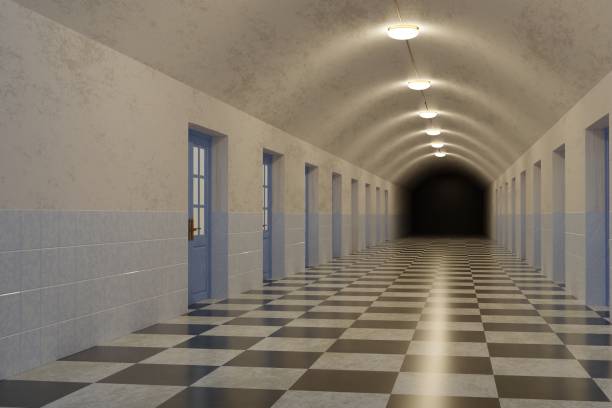Before the 1960s, in Quebec, the fate of people with mental health challenges was imprisonment, sometimes for life, in large psychiatric institutions. It was the religious orders that ran the asylums and received state aid in the almost total absence of health professionals.
The 1960s
In 1961, Jean-Charles Pagé, ex-patient of Saint-Jean-de-Dieu Hospital, published the book Les fous crient au secours. In his book, he describes the poor living conditions, the use of electric shocks, straightjackets and isolation. Pagé denounces the administration of the premises by the nuns and the difficulty to obtain a real therapeutic follow-up. The afterword is written by Dr. Camille Laurin, psychiatrist and later politician who agrees with Pagé’s testimony. The book caused an uproar when it was released and a vast media campaign was launched to modernize psychiatric care in Quebec.
In fact, less than a month after the book was published, the Jean Lesage government sets up the Commission on Psychiatric Hospitals headed by Dr. Bédard, which proposed a profound change in the asylum model.
The 1970s
The 1970s were marked by a first wave of deinstitutionalization which involved moving large numbers of patients from asylums to smaller facilities in the community. We want to reduce the duration of hospitalization and the number of beds in large psychiatric hospitals. The establishment of psychiatric departments in general hospitals is the principal measure to decentralize services and bring them closer to citizens. It is also increasing the number and diversity of professionals trained to work in the psychiatric system. Psychiatric hospitals are bought by the government from religious orders.

Between 1970 and 1975, it's the time of the Castonguay-Nepveu reform, a reform of health and social services. This reform brought the recognition of the right to health, the adoption of the Act respecting the protection of the mentally ill (1972) and the creation of local community service centres for psychosocial purposes (CLSC) (1974). The Act on the Protection of the Mentally Ill of 1972 moved from exclusion to protection. It regulates involuntary hospitalization by limiting it to: “the person considered dangerous to himself or to others”. The imposition of a closed cure measure involves recourse to a court order and to the necessity of two medical certificates, and this measure is made mandatory.
Despite these reforms, the situation of persons living with mental health problems is very difficult. Inside the asylums, it describes “inhuman” practices, “ordinary atrocities”, “cold electroshock” the use of restraints, drug overdoses, prolonged internments with little or no medical follow-up and “great difficulties in communicating with psychiatrists”.
Newly established CLSCs are reluctant to provide front-line mental health services. With a few exceptions, it was not until the 2005 Mental Health Action Plan that the government mandated the creation of mental health services in the community.
The late 1970s and early 1980s
In the late 1970s, the alternative resources, self-help and advocacy groups start to exchange experiences to regroup and give birth, in 1983, to the Regroupement des ressources alternatives en santé mentale du Québec (RRASMQ). The mission of the RRASMQ (1983) targets several objectives, including: promoting and defending the rights and interests of psychiatric people and those experiencing emotional and psychological problems; promoting changes in laws; denouncing the abuses of traditional psychiatry and any behavioural control techniques; fighting against prejudices about “madness”, and for the right to be different; promoting the creation and the maintenance of sufficient and adequate resources outside the traditional framework.

The 1980s
In the early 1980s, the aim to impose the voices of people with mental illness in public bodies where policies were developed.
Mental health community organizations are very actively involved in the legislative reforms of the time, including the reform of the Civil Code. They are meant for the protection of the rights of persons living with health problems and ally themselves with other minority groups, mainly persons living with physical handicaps. The priority is to harmonize the provisions of the Civil Code with the Quebec Charter of Rights and Freedoms and the Canadian Charter of Rights and Freedoms.
Mental health advocacy groups take several actions at the same time: the right to consent to care, the limits and the regulation of the use of involuntary institutional custody and the use of isolation, control, physical and chemical restraint measures, and finally rules governing the declaration of incapacity and public curatorship.
The rights advocacy group plays a central role to rigorously document the abuses and the absence of rights of recognition of the rights in institutions. They initiate or support lawsuits that bring about changes to the laws concerning the protection of the people living with mental health challenges.
Outrage over conditions in asylums, the deinstitutionalization project and the desire to create accessible services in the community are shared by many government officials and health professionals. Even if resistance is important, the voice of psychiatric people and a conception of rights and practices outside asylums find support to consolidate. Stakeholders who support changes within the government rely on the action of advocacy groups and alternative resources.
At the Ministry of Health, some officials acknowledge the rigour of the critical work done by alternative and rights movement. This makes it easier to secure funding for community initiatives.
Quebec Mental Health Policy (1989)
In 1989, the Quebec Mental Health Policy was created. This policy places the person at the centre of mental health services and suggests a broader partnership between the person, their loved ones, public mental health services and community organizations. It recognizes and ensures funding of self-help groups, establishes advocacy organizations and beneficiary committees in psychiatric institutions.

The 1990s
Following the adoption of the Quebec Mental Health Policy (1989), regional groups for the promotion and defence of rights were set up, and in 1990, the Association des groupes d’intervention en défense de droits en santé mentale du Québec (AGIDD-SMQ) was born. These groups provide the individual support, training on rights and remedies of people living with a mental health problem.
The AGIDD-SMQ puts forward the common fundamental values that support the practices of its member groups, such as social justice and the principle of favourable bias, which implies giving credibility to the person and his or her complaints to support him or her in defending his or her rights. The global vision of the person and the appropriation of power include core values of advocacy groups and alternative resources.
In 1996, Mr. Rochon, Minister of Health and Social Services, introduced Bill 39, originally entitled An Act respecting the protection of persons with mental illness, which amends the 1972 Act. The Minister aims therefore to establish a better balance between the rights of people living with mental health problems and the rights of the community and public safety. Following mobilizations, it became the Act respecting the protection of persons whose mental state presents a danger to themselves or to others. These new legislative provisions prevent the confusion between dangerousness and mental illness. In other words, a person can be dangerous without having a mental illness.
The 1990s are marked by an increased participation of people with mental health challenges by advocacy groups and alternative resources. They are increasingly taking up space in seminars and public consultations. Alternative resources train and prepare them to participate in government committees and public commissions. Their experiences are valued: they are often hired as speakers or trainers.
The 2000s
As of 2003, the Charest government, with a view of reducing the size of the state, proposed a major reform of the health and social services system. The aim, among other things, is to eliminate the regional health and social services agencies, regional public planning bodies. The Liberal government of Jean Charest abolished the Comité de la santé mentale du Québec (CSMQ), which had played a role in the reflection and public consultations for deinstitutionalization and in the development of proposals from the community movement. In 2004, 95 health and social services centres (CSSSs) were established across the province, merging CHSLDs, hospitals and CLSCs.
In 2005, the Charest government developed a new action plan for the period 2005-2010, entitled La force des liens. This action plan maintains the principle of ownership of power and introduces the participation of those directly concerned at the heart of its orientations. In particular, it gives priority to the recovery of the whole person and recognizes the ability of people living with a mental health problem to make choices and actively participate in decisions that affect them.
The Action Plan establishes front-line mental health teams and community follow-up teams for people living with severe and persistent mental health problems. Community organizations contribute to the achievement of the objectives of the Action Plan from a perspective of complementarity of services.
In 2007, les Porte-Voix du rétablissement was created by users Luc Vigneault, Nathalie Lagueux and Véronique Bizier. The priorities of this national association were the integration of experiential knowledge in the treatment teams, peer-to-peer support, self-management (Self-Medication), the strengths-based approach, the recovery-oriented approach and anti-stigma.
Autonomous medication management
The goal of Independent Mental Health Medication Management is to allow the person that takes the medication to get closer to a medication that suits them and that is part of a broader process to improve their well-being and regain control over their lives.
The Recovery Approach
In the recovery-oriented approach, the rights of the people that have a mental health problem take center stage. This emphasizes the recognition of each person: 1) the right to have his own personal objectives and to make their life choices; 2) the right to participate in the development of one’s individualized service plan; 3) the right to receive information about one’s illness and the side effects of the medication; 4) the right to refuse treatment; and 5) the right to be treated with respect, dignity and compassion.
Recovery-oriented services refer to services directly in the people’s living environment, determined according to their personal goals and based on equal and supportive relationships. By emphasizing on the rights and responsibilities of the people, the recovery transforms all their perception of how services are provided. Around the world, the recovery concept and the importance of empowerment of people with mental illness are increasingly recognized as guiding principles in the development of mental health care systems. By basing its action plan on these principles, Quebec adopts an approach that respects the individual and encourages their participation in society.

Mental Health Action Plan (MHAP) 2015-2020
The objective of the Mental Health Action Plan Faire ensemble et autrement is to provide ongoing access to a variety of mental health services, particularly through the implementation of front-line services and the establishment of new ways of collaboration between institutions and stakeholders.
It is a continuation of the previous mental health action plan La force des liens. The 2015-2020 MHAP is based on the interdisciplinary and intersectoral collaboration. It also aims the promotion of mental health and the prevention of mental disorders and suicide. The orientations of the MHAP are: 1) promote the primacy of the person and the full exercise of citizenship; 2) provide appropriate care and adaptive services for young people from birth to adulthood; foster clinical and management practices that improve the care experience; Ensure the performance and continuous improvement of mental health care and services.

Conclusion
Before the 1960s, in Quebec, the fate of people with mental health challenges was the confinement in large psychiatric hospitals. The 1960s were marked by a profound questioning of the asylum model. In the 1970s , it’s the start of deinstitutionalization and the era of the Castonguay-Nepveu reform. At the beginning of the 1980s, the aim was to impose the voice of people with mental illness in public policy-making bodies. At the end of the 1980s, Quebec’s Mental Health Policy was created, which placed the person at the centre of mental health services.
The 1990s saw increased participation of people with mental health challenges in advocacy groups and alternative resources. In the 2000s, the Action Plan La Force des liens was developed, followed by the Action Plan Faire ensemble et autrement. The recovery-oriented approach characterizes the 2000s, where the rights of people with mental health problems are central.
All told, in nearly 60 years, in Quebec, people with mental health challenges have gone from a position of dependence on psychiatric hospitals to a reappropriation of power over their lives.

Article intéressant sur l’histoire de la santé mentale au Québec. On peut voir qu’on a évolué, mais il reste encore du chemin à parcourir.